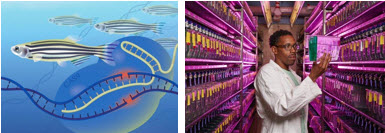Last updated: September 06, 2016
July 5 2016 The Power Of Model Organisms For Studying Rare Diseases
The Power of Model Organisms for Studying Rare Diseases
July 5, 2016
With the human genome consisting of billions of chemical units, scientists have a tremendous amount of information to sift through to understand how the genome works and how it influences human health and disease. Oftentimes, scientists encounter a genomic variant (i.e., an altered spelling) in a gene that they suspect might play a role in a disease being studied. But how do they prove such a relationship? Establishing such 'proof' can be quite challenging. But additional experimentation using model organisms can often provide a key piece of the puzzle.
Over many decades, organisms such as mice, fruit flies, and roundworms have become classic models for studying human biology and disease. Such 'model organisms' reproduce relatively fast and can be readily studied in laboratory settings. As such, scientists use model organisms to conduct experiments that cannot be performed with humans. A typical experiment involves altering a gene of interest in a model organism and seeing if the resulting phenotype mirrors that encountered in humans.
Human diseases are considered rare in the U.S. if they affect fewer than 200,000 people. According to the Genetics and Rare Diseases Information Center (GARD), "...there are more than 6,800 rare diseases. Altogether, rare diseases affect an estimated 25 million to 30 million Americans." Rare genetic diseases are typically transmitted from parents to offspring and involve mutations in a single gene; this makes them excellent targets for studies in model organisms.

Among the menagerie of model organisms studied by NHGRI-funded researchers is the zebrafish. The zebrafish has been used as an experimental model organism since the 1960s because of its small size, fast growth rate, and relatively inexpensive care requirements. As part of the Institute's Intramural Research Program, NHGRI is 'half owner' of one of the largest zebrafish research facilities in the world [with the other owner being The Eunice Kennedy Shriver National Institute of Child Health and Human Development (NICHD)]. Within this facility, NHGRI has developed the expertise to perform cutting-edge manipulations of the zebrafish genome, for example using the powerful CRISPR-Cas9 genome-engineering system. For any gene implicated in a human disease, NHGRI researchers can readily alter the corresponding gene in the zebrafish genome and then assess if the resulting mutant zebrafish has the same phenotypic features as the human disease.
As one illustrative example, Dan Kastner (NHGRI Scientific Director) and Shawn Burgess (Head of the NHGRI Developmental Genomics Section) used zebrafish to study a gene thought to be involved in strokes and vascular inflammation in children. Following the introduction of targeted mutations in the suspected gene, the resulting zebrafish mutants were found to exhibit stroke symptoms, yielding strong confirmation of the role of a suspected gene in the human disease.
Model organisms are now playing a major role in the NIH Common Fund's Undiagnosed Diseases Network (UDN). To augment their studies of patients with undiagnosed conditions, the UDN recently started a Model Organisms Screening Center that will use both zebrafish and fruit flies as models to study gene variants that are thought to be involved in unknown diseases in UDN patients. The NIH Undiagnosed Diseases Program (UDP), a predecessor and part of the current UDN, also collaborates with the previously mentioned zebrafish facility within the NHGRI Intramural Research Program.

Another NIH Common Fund program, the Knockout Mouse Phenotyping Program (KOMP2), a follow-on to the Knockout Mouse Project (KOMP), is an effort to create and characterize a collection of mice containing a null mutation - a mutation that results in a complete functional loss of a particular gene - in every gene in the mouse genome. The value of the mouse as a model organism comes from the fact that mice have similar developmental, physiological, biochemical, and behavioral features as humans. Therefore, advances in mouse genetics continue to be a driving force for a broad range of biomedical research activities, including the study of rare disease.
In summary, model organism research continues to play a central role in the study of human biology and disease. The above examples only represent a subset of the ways in which NHGRI programs capitalize on the powerful insights that model organisms provide about genome function. Meanwhile, it is fully anticipated that continued technological advances will increase the use of these 'critters' for helping us understand the complexities of human disease.
Last Updated: September 6, 2016
